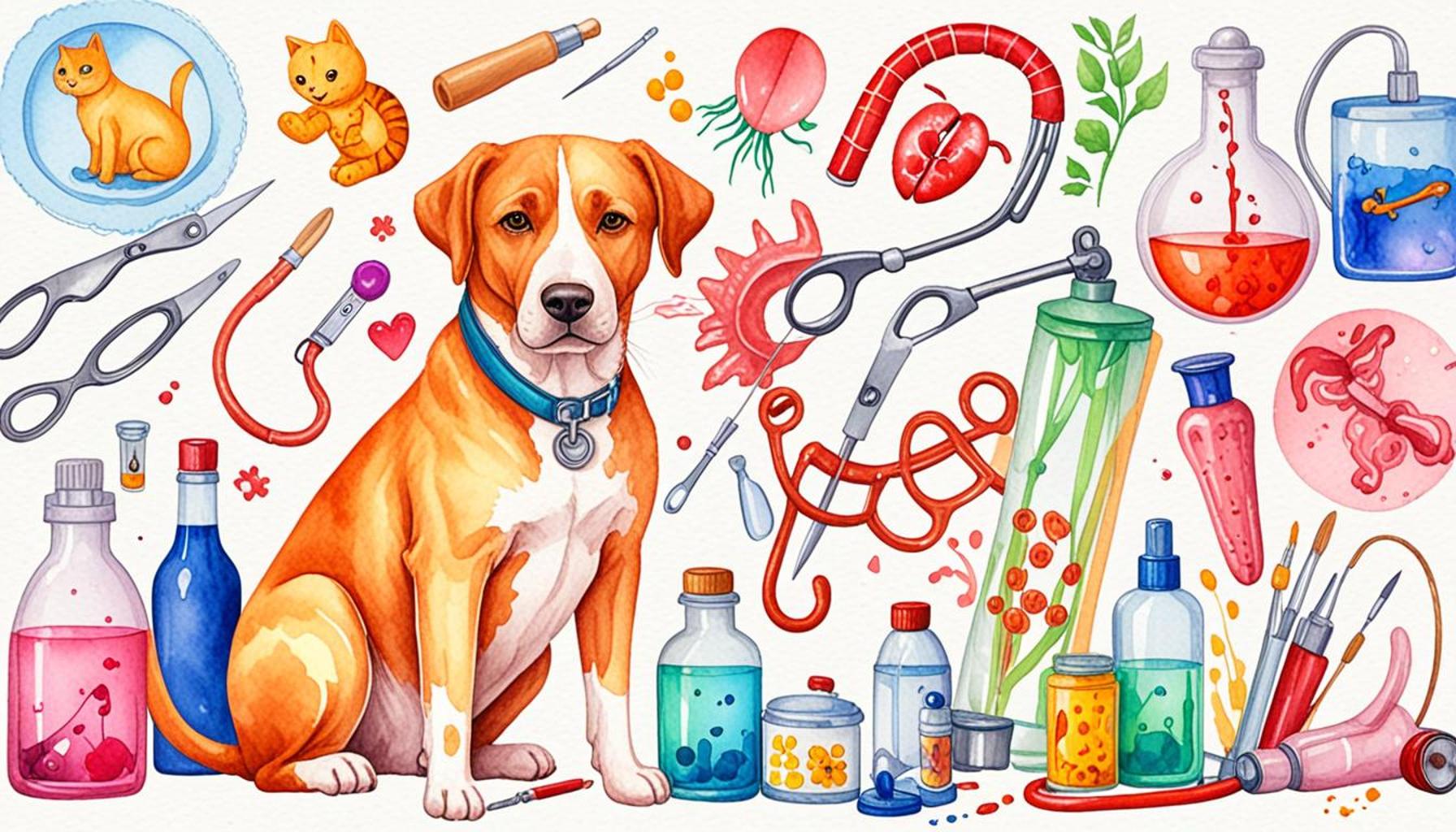Signs of Common Diseases in Pets: When to Seek Veterinary Help

Understanding the Signs of Health Issues in Pets
Our pets, whether they are dogs, cats, or other furry companions, bring immeasurable joy and companionship into our lives. However, their inability to express discomfort or illness in a way we can easily understand raises the importance of pet owners being vigilant about their health. Early recognition of health issues can be vital for effective treatment and improved quality of life.
Recognizing Behavioral Changes
One of the most telling indicators of a pet’s health is a change in their appetite. If your normally enthusiastic eater suddenly shows disinterest in food or, conversely, starts voraciously devouring meals, it can signal underlying health problems such as dental issues or gastrointestinal disorders. For example, dogs sometimes may refuse food when experiencing nausea or pain, while cats losing weight may be hiding more serious conditions like hyperthyroidism or cancer.
Similarly, behavioral shifts can provide insight into your pet’s health status. Pets that are usually playful and energetic may become excessively lethargic, indicating conditions like arthritis or heart disease. Conversely, a normally docile pet that becomes unusually agitated could be experiencing stress or discomfort. Pay attention to their interaction with family members and their environment; these behavioral changes can be key indicators of their overall well-being.
Grooming and Physical Symptoms
Changes in grooming patterns should not be overlooked. Excessive scratching or licking can point to skin allergies or infections, while neglecting grooming may indicate discomfort or depression. For cats, over-grooming can lead to bald spots, highlighting the need for closer observation. In addition, monitor for physical symptoms such as vomiting, diarrhea, or excessive drooling. These symptoms can arise from various issues, including dietary indiscretions, infections, or chronic conditions.
Understanding these signs is essential, as many serious health issues develop subtly. Diseases such as diabetes and kidney problems can progress over time, often going unnoticed until they reach critical stages. For instance, a diabetic dog may drink more water and urinate more frequently before being diagnosed, a change that some owners might attribute to mere aging.
Taking Action
Recognizing when to seek veterinary help can substantially improve treatment outcomes. If you notice persistent changes in your pet’s behavior or physical condition, consult with your veterinarian promptly. Regular check-ups can help catch chronic conditions early, allowing you to implement preventive measures or treatments before they escalate.
In conclusion, being proactive in recognizing health indicators not only contributes to the well-being of our beloved pets but also deepens the bond we share with them. Monitoring their behavior, grooming habits, and physical health can guide you in ensuring that your furry companions enjoy long, healthy lives.
DISCOVER MORE: Click here for essential tips
Common Physical Symptoms of Disease in Pets
When we think of our beloved pets, our minds often conjure images of their playful antics and endearing quirks. However, beneath this façade of happiness can lie signs of serious health conditions that require immediate attention. Recognizing physical symptoms in pets is crucial for pet owners, as they can be early indicators of health issues that may escalate if not addressed promptly.
Recognizing Digestive Disturbances
The digestive system is one of the most sensitive areas that can indicate health problems. Symptoms such as vomiting and diarrhea are often amongst the first signs a pet may display when something is amiss. While occasional vomiting might not be alarming, frequent occurrences could point to conditions such as pancreatitis or intestinal obstructions. Notably, a significant change in the frequency or consistency of your pet’s stool warrants a call to the veterinarian. For instance:
- Diarrhea: When your pet has loose stools lasting more than a day, this could lead to dehydration, especially in cats.
- Vomiting: If your pet is vomiting multiple times in a day, this is not typical and should be investigated.
- Abdominal discomfort: If your pet is unusually lethargic, refuses to be touched around the stomach, or assumes a “praying” position (forelegs on the ground while the back is raised), it may suggest a serious issue.
Evaluating Skin and Coat Health
Your pet’s skin and coat can reveal a lot about its health. If you notice adverse changes such as excessive shedding, bald patches, or persistent itching, it could indicate allergies, parasites, or infections. Pay attention to:
- Red or inflamed skin: This can be a sign of allergies or dermatitis, which may require treatment and dietary adjustments.
- Foul odor: A noticeable smell could indicate an infection, particularly in areas like the ears or between the toes.
- Changes in coat texture or color: A dull or coarse coat can indicate nutritional deficiencies or underlying health issues.
Another significant indicator of health issues is weight fluctuations. Both unexplained weight loss and sudden weight gain in pets can point towards serious concerns, including metabolic disorders, diabetes, or even malignancies. As a rule of thumb, a weight change of more than 10% should raise a red flag, prompting a discussion with your veterinarian.
Note the Importance of Regular Check-Ups
In addition to being observant about these physical signs, regular veterinary check-ups play an instrumental role in maintaining your pet’s health. Many conditions can be asymptomatic in early stages, making it crucial to engage in preventive care. This includes routine blood tests, vaccinations, and discussions about diet and exercise. By staying proactive, you can ensure that any underlying conditions are addressed before they become significant health threats.
| Category | Key Features |
|---|---|
| Increased Thirst and Urination | Common signs of kidney disease or diabetes. |
| Persistent Coughing | May indicate respiratory infections or heart disease. |
| Excessive Weight Loss | A significant sign of underlying metabolic or digestive disorders. |
| Changes in Behavior | Sudden lethargy or aggression could signal distress or pain. |
| Vomiting and Diarrhea | Frequent occurrences may indicate gastrointestinal issues or poisoning. |
When observing changes in your pet’s health, it is crucial to respond promptly. Each symptom can reflect various underlying health issues that warrant a thorough veterinary evaluation. Recognizing these signs early can lead to timely treatment and a better prognosis for your furry friend. Is your pet showing any of these symptoms? Don’t hesitate; consult your veterinarian immediately to ensure that your pet gets the care it deserves!
DISCOVER MORE: Click here to learn about the importance of socialization in puppy training
Behavioral Changes as Indicators of Health Issues
Behavioral changes in pets can often go unnoticed until they become significant. Pets, just like humans, can exhibit a range of behaviors that may indicate underlying health issues. Understanding these changes is vital for early detection and intervention. Changes in behavior can manifest in various ways, and pet owners should stay vigilant for any shifts in their furry companions’ habits.
Unusual Lethargy and Withdrawal
Lethargy is one of the most concerning signs that a pet may not be well. A once-active dog or cat may suddenly prefer to sleep all day, show a decreased interest in play, or become less responsive to their owner. Pets are creatures of habit, and any significant deviation from their usual energy levels warrants investigation. Reasons for lethargy can range from viral infections to more severe conditions like cancer or heart disease. It’s essential to note:
- Refusal to engage: If your pet avoids playtime or social interactions, it could indicate discomfort or pain.
- Sudden change in sleep patterns: Increased sleep could be a sign of pain, illness, or even depression.
- Difficulty in mobility: If your pet struggles to get up or move around, seek veterinary assistance to rule out arthritis or injuries.
Appetite and Thirst Alterations
Changes in appetite and thirst are other critical indicators of health issues that should not be ignored. Both increased and decreased appetite can signify various conditions. For instance:
- Loss of appetite: If your pet refuses to eat for over 24 hours, this could suggest a serious underlying health issue such as dental disease, infection, or even organ failure.
- Increased thirst: Excessive drinking could be a sign of diabetes, kidney issues, or Cushing’s disease. Monitor any sudden shifts in your pet’s thirst levels closely.
- Picking at food: If your pet shows a lack of enthusiasm for their meals, it may point to dental problems or gastrointestinal discomfort.
The Importance of Recognizing Pain
Another critical area of concern is your pet’s expression of pain. Pets, by nature, often hide their discomfort until it becomes unbearable. Thus, recognizing subtle signals of pain can be instrumental in determining when veterinary help is needed. Signs to watch for include:
- Vocalizations: Increased whining, growling, or whimpering can be indicators that your pet is in pain.
- Changes in grooming: Excessive licking of a particular area or neglecting grooming can hint at discomfort or irritation.
- Body language: Watch for signs like panting, pacing, or holding a particular posture, which may suggest your pet is experiencing physical discomfort.
Additionally, behavioral changes can provide insight into emotional distress, which should also be considered. Stress and anxiety in pets can arise from changes in their environment, such as moving to a new home, the introduction of a new pet, or even changes in routine. These emotional states can lead to physical manifestations, making it essential to maintain a supportive environment for your pet’s mental well-being.
By understanding these behavioral changes, pet owners can become more attuned to their furry friends’ needs. Regular check-ins on your pet’s conduct, appetite, activity level, and overall demeanor help create a holistic picture of their health. Remember, early detection is the key to effective treatment and enhancing their quality of life.
DISCOVER MORE: Click here to learn about the latest trends
Conclusion: Staying Vigilant for a Healthy Pet
Recognizing the signs of common diseases in pets is crucial for every responsible pet owner. Our beloved animals rely on us to notice when something is not quite right in their behavior, appetite, or overall demeanor. Changes such as unusual lethargy, decreased appetite, or expressions of pain should never be taken lightly. These signals can often indicate that your pet may be experiencing underlying health issues that require immediate attention.
Proactive monitoring of your pet’s daily habits and changes in behavior is not just important for identifying health concerns but also for ensuring their ongoing well-being. Remember, early intervention can make a significant difference in treatment outcomes and quality of life. Regular veterinary check-ups are also key; they can catch potential issues before they escalate and help keep your furry friend healthy and happy.
In conclusion, understanding and recognizing behavioral changes and physical symptoms can equip you with the necessary tools to become an effective advocate for your pet’s health. When in doubt, don’t hesitate to consult a veterinarian. Your pet depends on your attentiveness and care. By staying informed and vigilant, you can ensure that your furry companion remains a vibrant part of your family for years to come.


